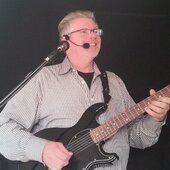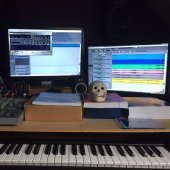-
Posts
3,360 -
Joined
-
Last visited
-
Days Won
22
bitflipper last won the day on June 12
bitflipper had the most liked content!
Reputation
4,479 ExcellentAbout bitflipper
- Birthday 10/02/1951
Recent Profile Visitors
The recent visitors block is disabled and is not being shown to other users.
-

Best of Cowbell...And the Nominees Are...
bitflipper replied to bitflipper's topic in The Coffee House
Best cowbell intro? -
Best use of a cowbell in psychedelia:
-
-
Been down a Molly Tuttle rabbit hole today...an apt analogy since I started this morning with her band's imaginative rendition of White Rabbit. You don't even have to like Bluegrass to appreciate the musicianship and creativity of this band.
-
Just in case you weren't convinced that Brian was a frickin' genius...
-
This update to the venerable Zebra 2 has been teased for years. I'd given up that it would ever see the light of day, but here's Urs showing an alpha version of Z3. It looks a lot like Z2, which to my mind is a good thing because it took me a long time to wrap my head around Z2. But now with FM synthesis! Back when Z3 was first discussed on KVR, Urs had promised a $49 upgrade price for Z2 owners. It appears he has't forgotten that promise, as he mentions an even better 30 EUR upgrade price in this video. Zebra 2 has been my primary go-to synth for a very long time. It and Omnisphere are the two synths I use in every project. So yeh, I'll be first in line when Z3 is released.
- 1 reply
-
- 5
-

-

Half a Century Late, I Discovered This Haunting Voice
bitflipper replied to bitflipper's topic in The Coffee House
Yep, it's the Elvis tune Can't Help Falling in Love - but with cooler chords. There are couple vids on YT with her performing Plasir d'amour with Joan Baez, one of which shows the latter clearly struggling with the guitar chords. -
Hard to imagine this melody is 300 years old. You don't need to speak French to figure out what it's about. For bonus points, guess which 60's pop song is based on it.
-
With the decline of commercial radio as the primary arbiter of what's good, we older folk have come to appreciate the value of human-curated playlists and to mourn its loss. But there are still radio stations that are doing it, they're just scattered around the world. Your new favorite music might be playing right now on a college radio station in France, you just don't know it. Check out ScrobbleRadio. At the moment I'm listening to a station called SomaFM Folk Forward, and enjoying it quite a lot. Despite the name, it's not really folk music, unless this is what they call folk music nowadays. I wouldn't know. It's a diverse collection, the nearest I can discern as a common thread it that it seems to be heavy on acoustic guitar and melodic. ScrobbleRadio's FAQ says the site is oriented toward "scrobbling". I didn't know what that was, had to look it up. For those similarly ignorant, it's a term coined by last.fm for a method of tracking what you've listened to online. Which is why I wouldn't be familiar with it - I don't listen to streaming music, preferring to purchase albums and store them in a portable music player. I definitely never listen to music on my phone. Ugh. The service is free and you don't have to create an account. Scrobbling is optional.
-
The first album I ever heard in stereo: Magical Mystery Tour. I had an epiphany right then and there, that the studio itself could be part of the creative process. From a musical perspective, the album that inspired me most was In the Court of the Crimson King. It was a bolt of lightning, showing me that rock, jazz and classical were all just different facets of the same gem. For emotional impact, it would be the first Black Sabbath album. It was my first time listening on headphones. "I am Iron Man" emanating from the middle of my head! Well, I was also on acid, so there's that. For musical inspiration, Time Out by Dave Brubeck and its follow-up, Time Further Out. Prior to that, I thought that all music was in 4/4, 3/4 or 6/8. Not only was 7/4 a viable option, you could even dance to it. Look it up on YouTube; there is a live performance of Unsquare Dance with (admittedly pro) dancers having no problem bouncing along to its odd time signature. Honorable mention: Hope by Klaatu, an epic concept album on par -imo- with Dark Side of the Moon. I bought it on cassette while on the road and fell asleep to it every night that summer. Our drummer was also a big fan of it, so when he bought a Sony reel-to-reel with sound-on-sound, Hope was in our minds as we began experimenting. That was my first non-studio recording. Can't call it a home recording as it was in a motel room in Idaho.
-

Introducing Velvet, A smarter de-esser for smoother vocals | iZotope
bitflipper replied to Larry Shelby's topic in Deals
I dunno, $39 would be a great deal for somebody who doesn't already have a de-esser and a spectral compressor. Such a consumer probably falls right into iZotope's marketing demographic. Next ground-breaking product: a combination bitcrusher + cheese straightener! Part of a new suite of things you never knew you needed. -
Next you're gonna tell me that music production is similar fakery.
-
Thanks for that, Marc. I was so disappointed with the first album that I never gave the band a second chance. But your comment spurred me to give it a listen. You're right - it's pretty good. I know there's a lot of good stuff from the 90's that I missed due to spending that decade completely disconnected from popular music. It was disco that pushed me away in the 80's, resulting in a retreat to the music of my youth, primarily oldies from the 19th century. The Brandenburg Concertos - that's the soundtrack of my youth, my musical comfort food.





.thumb.jpg.eaad641f73d276ceb5533b13026779ae.jpg)

